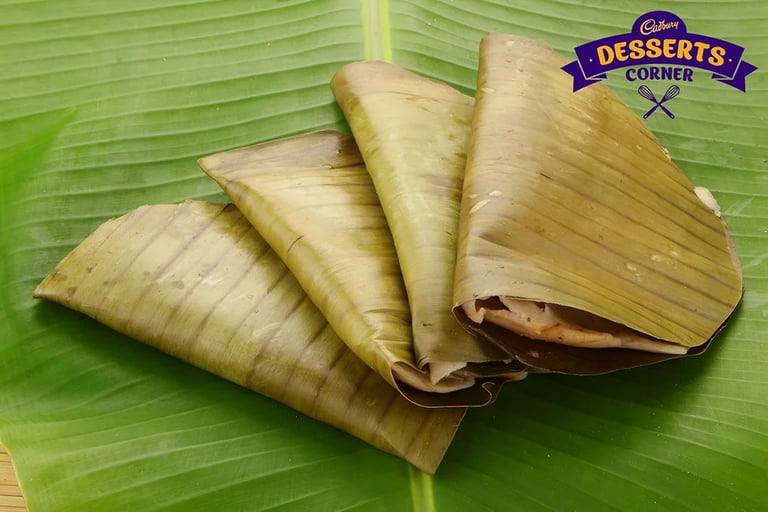Home![]() Articles
Articles![]() Here is a List of the Best Leaf-Wrapped Desserts You Can Find Across India
Here is a List of the Best Leaf-Wrapped Desserts You Can Find Across India
India’s cuisine is diverse and varied. But among cultures, similarities emerge. Leaf wrapped desserts are just one point of connection.

India’s cuisine is diverse and varied. But among cultures, similarities emerge. Leaf wrapped desserts are just one point of connection.
In the realm of Indian desserts, there’s an endless and delectable variety. Each state, region and culture has given birth to its own desserts and sweets. In keeping with the breathtaking diversity of India’s cuisine, we thought of grouping desserts together based on technique. And the technique we’re focusing on here is that of wrapping leaves around desserts. Wrapping food in leaves is a long and deeply rooted practice in India. Not only is it symbolic of different layers of protection, it's also a practical and ecofriendly way of protecting food. And the cuisine has created desserts in a way that the leaves contribute not just to look but to flavor as well. Often sourced from plants like banana and palm, these leaves are a symbol of connection with a longstanding and proud tradition.
Therali Kozhukattai
Originating from the southern state of Tamil Nadu, the therali kozhukattai is a type of sweet dumpling wrapped in leaves. To make it, freshly grated coconut, jaggery, cardamom powder and raisins or cashews are mixed together and shaped into small spheres. In fact, kozhukattai is Tamil for ‘small coconut balls’. And therali means palmyra palm, whose leaves are used to wrap the balls. Each leaf’s midrib is removed and the leaf is wrapped tightly around the ball, and sealed shut from the side. This is then steamed, during which process the sphere acquires flavor from the leaf. The dessert is said to have originated from the state’s rural and agricultural communities, where women would come together and make hundreds of such balls for festivals and for temple prasadam.
Ela Ada

From Kerala, boasting a rich Malayali culture, comes ela ada, which is essentially a sweetened rice cake wrapped in leaves. In fact, ela means leaf and ada is ‘steamed rice cake’. It can be enjoyed as breakfast or as an evening snack. It's made by mixing together raw rice flour, grated coconut and jaggery, which is then wrapped into a banana leaf. To make it, the coconut and jaggery mixture is added to thin rice dough and then skillfully folded into the leaf. As it steams, the banana leaf’s earthy aroma seeps into the mixture. The result is a masterful blend of flavor and texture. The ela ada is often made during festivals and social gatherings and highlights Kerala’s sense of community and togetherness. Today, there are modern iterations of this simple and charming dish, using ingredients like chocolate and jackfruit.
Patoli
Hailing from Goa, patoli is a delicate balance of sweet and savory flavors, wrapped in aromatic turmeric leaves. The filling is made of rice, coconut and jaggery, and topped with spices like nutmeg, which is then wrapped in the leaves. The dish is an excellent representation of Goa’s diversity and culinary simplicity, and is often enjoyed during festivals like Ganesh Chaturthi, shravan and nag panchami. It is believed that goddess Parvati had a strong craving for these during her pregnancy and patoli without salt is offered to Her.
Idiyo
Originating from Karnataka’s Mangalore, Idiyo is a type of steamed rice dumpling wrapped in jackfruit leaves, that’s deeply popular among locals. To make it, a blend of rice flour, grated coconut, jaggery and cardamom is mixed together to form a smooth batter. The batter is wrapped in the leaves to create small parcels which are then steamed until cooked. The jackfruit leaves add a subtle flavor and kick to the dish that’s sweet and simple in essence.
Bhapa Shondesh Paturi
From the eastern state of West Bengal comes the bhapa shondesh paturi, a culinary masterpiece. Bhapa means steamed and paturi means wrapped in leaves, signaling the two distinct techniques this dish brings together. To make it, chhena or fresh cottage cheese is sweetened, infused with cardamom, and shaped into patties or discs. These are then topped with a layer of soaked dates that have pureed, and then wrapped in banana leaves. These are then steamed until cooked, which allows the flavors to seep into each other and come mesmerizingly together. The leaves offer the shondesh a slight herbal essence and infuse it with their thick aroma, while the dates are rich in sweetness and a natural stickiness, and the entire dish is a celebration of flavor and texture.






















